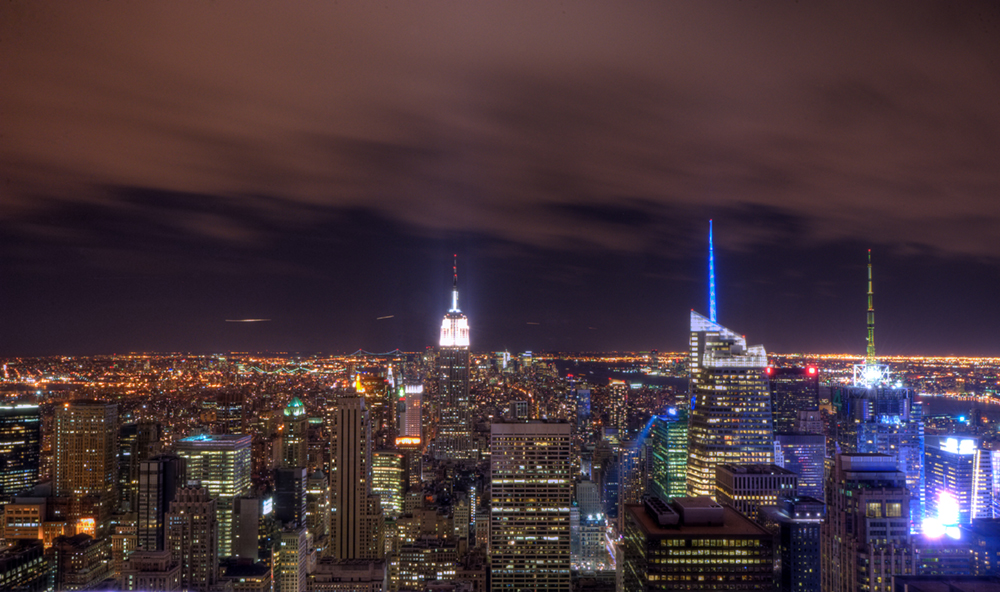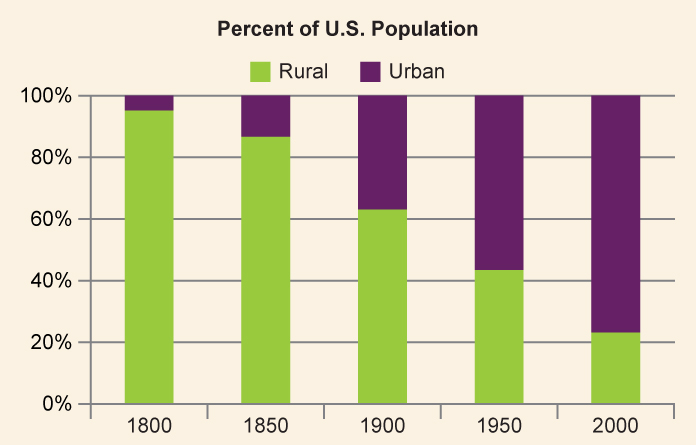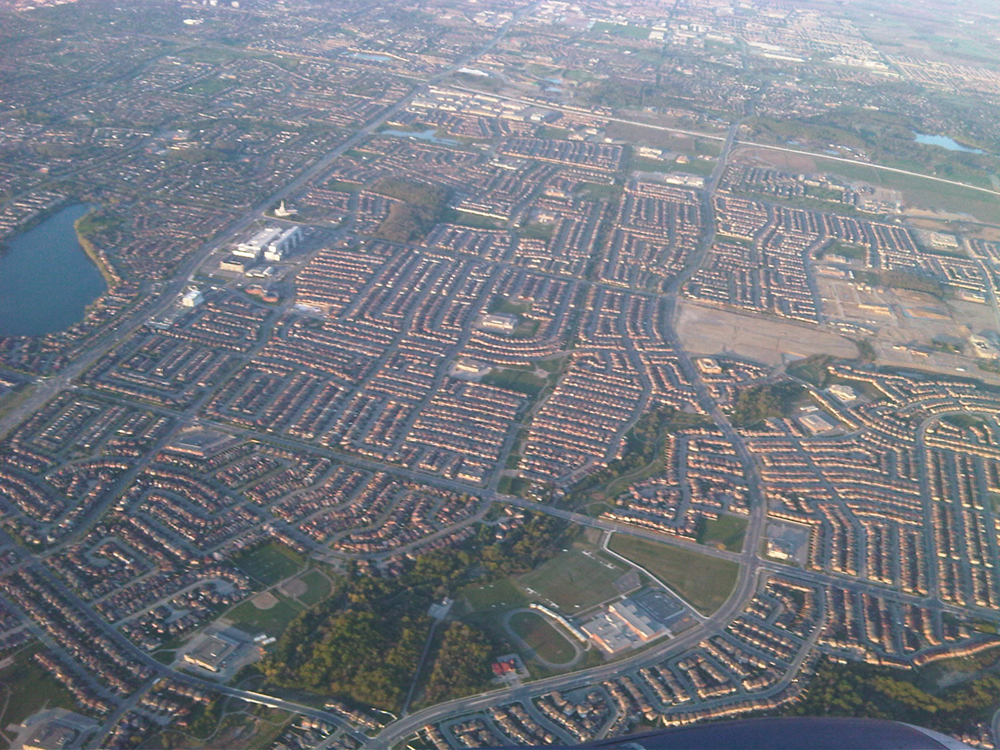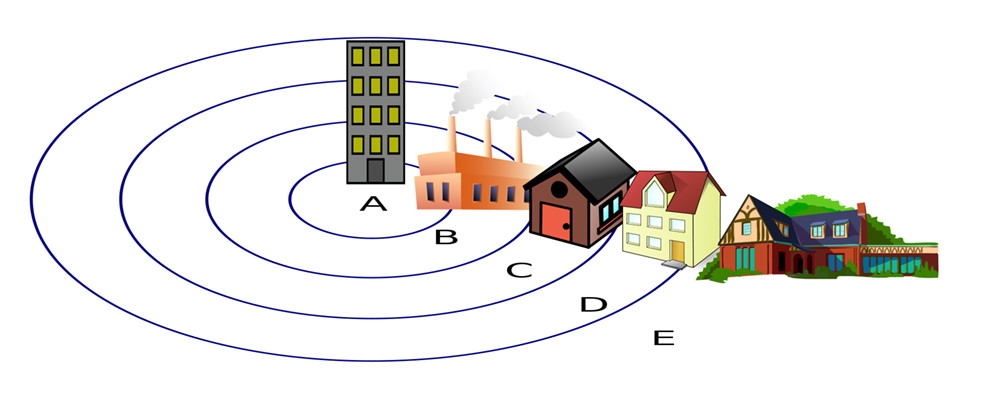Population, Urbanization, and the Environment
90 Urbanization
Learning Objectives
- Describe the process of urbanization in the United States and the growth of urban populations worldwide
- Understand the function of suburbs, exurbs, and concentric zones
- Discuss urbanization from various sociological perspectives

Urbanization is the study of the social, political, and economic relationships in cities, and someone specializing in urban sociology studies those relationships. In some ways, cities can be microcosms of universal human behavior, while in others they provide a unique environment that yields its own brand of human behavior. There is no strict dividing line between rural and urban; rather, there is a continuum where one bleeds into the other. However, once a geographically concentrated population has reached approximately 100,000 people, it typically behaves like a city regardless of what its designation might be.
The Growth of Cities
According to sociologist Gideon Sjoberg (1965), there are three prerequisites for the development of a city: First, good environment with fresh water and a favorable climate; second, advanced technology, which will produce a food surplus to support nonfarmers; and third, strong social organization to ensure social stability and a stable economy. Most scholars agree that the first cities were developed somewhere in ancient Mesopotamia, though there are disagreements about exactly where. Most early cities were small by today’s standards, and the largest was most likely Rome, with about 650,000 inhabitants (Chandler and Fox 1974). The factors limiting the size of ancient cities included lack of adequate sewage control, limited food supply, and immigration restrictions. For example, serfs were tied to the land, and transportation was limited and inefficient. Today, the primary influence on cities’ growth is economic forces. Since the recent economic recession reduced housing prices, researchers have been waiting to see what happens to urban migration patterns in response.

Urbanization in the United States
Urbanization in the United States proceeded rapidly during the Industrial Era. As more and more opportunities for work appeared in factories, workers left farms (and the rural communities that housed them) to move to the cities. From mill towns in Massachusetts to tenements in New York, the industrial era saw an influx of poor workers into U.S. cities. At various times throughout the country’s history, certain demographic groups, from post-Civil War southern Blacks to more recent immigrants, have made their way to urban centers to seek a better life in the city.
In 2013, the number of refugees, asylum-seekers, and internally displaced people worldwide exceeded 50 million people for the first time since the end of World War II. Half these people were children. A refugee is defined as an individual who has been forced to leave his or her country in order to escape war, persecution, or natural disaster, while asylum-seekers are those whose claim to refugee status has not been validated. An internally displaced person, on the other hand, is neither a refugee nor an asylum-seeker. Displaced persons have fled their homes while remaining inside their country’s borders.
The war in Syria caused most of the 2013 increase, forcing 2.5 million people to seek refugee status while internally displacing an additional 6.5 million. Violence in Central African Republic and South Sudan also contributed a large number of people to the total (The United Nations Refugee Agency 2014).
The refugees need help in the form of food, water, shelter, and medical care, which has worldwide implications for nations contributing foreign aid, the nations hosting the refugees, and the non-government organizations (NGOs) working with individuals and groups on site (The United Nations Refugee Agency 2014). Where will this large moving population, including sick, elderly, children, and people with very few possessions and no long-term plan, go?
Suburbs and Exurbs
As cities grew more crowded, and often more impoverished and costly, more and more people began to migrate back out of them. But instead of returning to rural small towns (like they’d resided in before moving to the city), these people needed close access to the cities for their jobs. In the 1850s, as the urban population greatly expanded and transportation options improved, suburbs developed. Suburbs are the communities surrounding cities, typically close enough for a daily commute in, but far enough away to allow for more space than city living affords. The bucolic suburban landscape of the early twentieth century has largely disappeared due to sprawl. Suburban sprawl contributes to traffic congestion, which in turn contributes to commuting time. And commuting times and distances have continued to increase as new suburbs developed farther and farther from city centers. Simultaneously, this dynamic contributed to an exponential increase in natural resource use, like petroleum, which sequentially increased pollution in the form of carbon emissions.
As the suburbs became more crowded and lost their charm, those who could afford it turned to the exurbs, communities that exist outside the ring of suburbs and are typically populated by even wealthier families who want more space and have the resources to lengthen their commute. Together, the suburbs, exurbs, and metropolitan areas all combine to form a metropolis. New York was the first U.S. megalopolis, a huge urban corridor encompassing multiple cities and their surrounding suburbs. These metropolises use vast quantities of natural resources and are a growing part of the U.S. landscape.

What makes a suburb a suburb? Simply, a suburb is a community surrounding a city. But when you picture a suburb in your mind, your image may vary widely depending on which nation you call home. In the United States, most consider the suburbs home to upper— and middle—class people with private homes. In other countries, like France, the suburbs––or “banlieues”–– are synonymous with housing projects and impoverished communities. In fact, the banlieues of Paris are notorious for their ethnic violence and crime, with higher unemployment and more residents living in poverty than in the city center. Further, the banlieues have a much higher immigrant population, which in Paris is mostly Arabic and African immigrants. This contradicts the clichéd U.S. image of a typical white-picket-fence suburb.
In 2005, serious riots broke out in the banlieue of Clichy-sous-Bois after two boys were electrocuted while hiding from the police. They were hiding, it is believed, because they were in the wrong place at the wrong time, near the scene of a break-in, and they were afraid the police would not believe in their innocence. Only a few days earlier, interior minister Nicolas Sarkozy (who later became president), had given a speech touting new measures against urban violence and referring to the people of the banlieue as “rabble” (BBC 2005). After the deaths and subsequent riots, Sarkozy reiterated his zero-tolerance policy toward violence and sent in more police. Ultimately, the violence spread across more than thirty towns and cities in France. Thousands of cars were burned, many hundreds of people were arrested, and both police and protesters suffered serious injuries.
Then-President Jacques Chirac responded by pledging more money for housing programs, jobs programs, and education programs to help the banlieues solve the underlying problems that led to such disastrous unrest. But none of the newly launched programs were effective. Sarkozy ran for president on a platform of tough regulations toward young offenders, and in 2007 the country elected him. More riots ensued as a response to his election. In 2010, Sarkozy promised “war without mercy” against the crime in the banlieues (France24 2010). Six years after the Clichy-sous-Bois riot, circumstances are no better for those in the banlieues.
As the Social Policy & Debate feature illustrates, the suburbs also have their share of socio-economic problems. In the United States, white flight refers to the migration of economically secure white people from racially mixed urban areas and toward the suburbs. This occurred throughout the twentieth century, due to causes as diverse as the legal end of racial segregation established by Brown v. Board of Education to the Mariel boatlift of Cubans fleeing Cuba’s Mariel port for Miami. Current trends include middle-class African-American families following white flight patterns out of cities, while affluent whites return to cities that have historically had a black majority. The result is that the issues of race, socio-economics, neighborhoods, and communities remain complicated and challenging.
Urbanization around the World
During the Industrial Era, there was a growth spurt worldwide. The development of factories brought people from rural to urban areas, and new technology increased the efficiency of transportation, food production, and food preservation. For example, from the mid-1670s to the early 1900s, London’s population increased from 550,000 to 7 million (Old Bailey Proceedings Online 2011). Global favorites like New York, London, and Tokyo are all examples of postindustrial cities. As cities evolve from manufacturing-based industrial to service- and information-based postindustrial societies, gentrification becomes more common. Gentrification occurs when members of the middle and upper classes enter and renovate city areas that have been historically less affluent while the poor urban underclass are forced by resulting price pressures to leave those neighborhoods for increasingly decaying portions of the city.
Globally, 54 percent of the world’s 7 billion people currently reside in urban areas, with the most urbanized region being North America (82 percent), followed by Latin America/the Caribbean (80 percent), with Europe coming in third (72 percent). In comparison, Africa is only 40 percent urbanized. With 38 million people, Tokyo is the world’s largest city by population. The world’s most densely populated cities are now largely concentrated in the global south, a marked change from several decades ago when the biggest cities were found in the global north. In the next forty years, the biggest global challenge for urbanized populations, particularly in less developed countries, will be to achieve development that occurs without depleting or damaging the natural environment, also called sustainable development (United Nations, Department of Economic and Social Affairs, Population Division 2014).
Theoretical Perspectives on Urbanization
The issues of urbanization play significant roles in the study of sociology. Race, economics, and human behavior intersect in cities. Let’s look at urbanization through the sociological perspectives of functionalism and conflict theory. Functional perspectives on urbanization generally focus on the ecology of the city, while conflict perspective tends to focus on political economy.
Human ecology is a functionalist field of study that looks at on the relationship between people and their built and natural physical environments (Park 1915). Generally speaking, urban land use and urban population distribution occur in a predictable pattern once we understand how people relate to their living environment. For example, in the United States, we have a transportation system geared to accommodate individuals and families in the form of interstate highways built for cars. In contrast, most parts of Europe emphasize public transportation such as high-speed rail and commuter lines, as well as walking and bicycling. The challenge for a human ecologist working in U.S. urban planning is to design landscapes and waterscapes with natural beauty, while also figuring out how to provide for free-flowing transport of innumerable vehicles, not to mention parking!
The concentric zone model (Burgess 1925) is perhaps the most famous example of human ecology. This model views a city as a series of concentric circular areas, expanding outward from the center of the city, with various “zones” invading adjacent zones (as new categories of people and businesses overrun the edges of nearby zones) and succeeding (then after invasion, the new inhabitants repurpose the areas they have invaded and push out the previous inhabitants). In this model, Zone A, in the heart of the city, is the center of the business and cultural district. Zone B, the concentric circle surrounding the city center, is composed of formerly wealthy homes split into cheap apartments for new immigrant populations; this zone also houses small manufacturers, pawn shops, and other marginal businesses. Zone C consists of the homes of the working class and established ethnic enclaves. Zone D holds wealthy homes, white-collar workers, and shopping centers. Zone E contains the estates of the upper class (in the exurbs) and the suburbs.

In contrast to the functionalist approach, theoretical models in the conflict perspective focus on the way urban areas change according to specific decisions made by political and economic leaders. These decisions generally benefit the middle and upper classes while exploiting the working and lower classes.
For example, sociologists Feagin and Parker (1990) suggested three factors by which political and economic leaders control urban growth. First, these leaders work alongside each other to influence urban growth and decline, determining where money flows and how land use is regulated. Second, exchange value and use value of land are balanced to favor the middle and upper classes so that, for example, public land in poor neighborhoods may be rezoned for use as industrial land. Finally, urban development is dependent on both structure (groups such as local government) and agency (individuals including businessmen and activists), and these groups engage in a push-pull dynamic that determines where and how land is actually used. For example, Not In My Back Yard (NIMBY) movements are more likely to emerge in middle and upper-class neighborhoods as engaged citizens protest poor environmental practices they fear will affect them, so these groups have more control over the use of local land.
Summary
Cities provide numerous opportunities for their residents and offer significant benefits including access to goods to numerous job opportunities. At the same time, high population areas can lead to tensions between demographic groups, as well as environmental strain. While the population of urban dwellers is continuing to rise, sources of social strain are rising along with it. The ultimate challenge for today’s urbanites is finding an equitable way to share the city’s resources while reducing the pollution and energy use that negatively impacts the environment.
Section Quiz
In the concentric zone model, Zone B is likely to house what?
- The city’s industrial center
- Wealthy commuter homes
- Formerly wealthy homes split into cheap apartments
- Rural outposts
C
What are the prerequisites for the existence of a city?
- Good environment with water and a favorable climate
- Advanced agricultural technology
- Strong social organization
- All of the above
D
In 2014, what was the largest city in the world?
- Delhi
- New York
- Shanghai
- Tokyo
D
What led to the creation of the exurbs?
- Urban sprawl and crowds moving into the city
- The high cost of suburban living
- The housing boom of the 1980s
- Gentrification
A
How are the suburbs of Paris different from those of most U.S. cities?
- They are connected by public transportation.
- There are more industrial and business opportunities there.
- They are synonymous with housing projects and urban poor.
- They are less populated.
C
How does gentrification affect cities?
- They become more crowded.
- Less affluent residents are pushed into less desirable areas.
- Traffic issues, including pollution, become worse.
- All of the above
B
What does human ecology theory address?
- The relationship between humans and their environments
- The way humans affect technology
- The way the human population reduces the variety of nonhuman species
- The relationship between humans and other species
A
Urbanization includes the sociological study of what?
- Urban economics
- Urban politics
- Urban environments
- All of the above
D
Short Answer
What are the differences between the suburbs and the exurbs, and who is most likely to live in each?
How will the growth in urban populations affect the world over the next ten years?
Considering the concentric zone model, what type of zone were you raised in? Is this the same or different as that of earlier generations in your family? What type of zone do you reside in now? Do you find that people from one zone stereotype those from another? If so, how?
Further Research
Interested in learning more about the latest research in the field of human ecology? Visit the Society for Human Ecology web site to discover what’s emerging in this field: http://openstax.org/l/human_ecology
Getting from place to place in urban areas might be more complicated than you think. Read the latest on pedestrian-traffic concerns at the Urban Blog web site: http://openstax.org/l/pedestrian_traffic
References
BBC. 2005. “Timeline: French Riots—A Chronology of Key Events.” November 14. Retrieved December 9, 2011 (http://news.bbc.co.uk/2/hi/europe/4413964.stm).
Burgess, Ernest. 1925. “The Growth of the City.” Pp. 47–62 in The City, edited by R. Park and E. Burgess. Chicago: University of Chicago Press.
Chandler, Tertius and Gerald Fox. 1974. 3000 Years of Urban History. New York: Academic Press.
Dougherty, Connor. 2008. “The End of White Flight.” Wall Street Journal, July 19. Retrieved December 12, 2011 (http://online.wsj.com/article/SB121642866373567057.html).
Feagin, Joe, and Robert Parker. 1990. Building American Cities: The Urban Real Estate Game. 2nd ed. Englewood Cliffs, NJ: Prentice Hall.
France24. 2010. “Sarkozy Promises War without Mercy for Paris Suburbs.” France 24, April 10. Retrieved December 9, 2011 (http://www.france24.com/en/20100420-sarkozy-war-suburbs-drugs-crime-violence-truancy-tremblay-en-france-saint-denis-france).
LeBlanc, Adrien Nicole. 2003. Random Family: Love, Drugs, Trouble and Coming of Age in the Bronx. New York: Scribner.
Park, Robert. 1934 [1915]. “The City: Suggestions for Investigations of Human Behavior in the City.” American Journal of Sociology 20:577–612.
Park, Robert. 1936. “Human Ecology.” American Journal of Sociology 42:1–15.
Old Bailey Proceedings Online. 2011. “Population History of London.” Retrieved December 11, 2011 (http://www.oldbaileyonline.org/static/Population-history-of-london.jsp).
Sciolino, Elaine, and Ariane Bernand. 2006. “Anger Festering in French Areas Scarred in Riots.” New York Times, October 21. Retrieved December 11, 2011 (http://www.nytimes.com/2006/10/21/world/europe/21france.html?scp=2&sq=paris+suburb&st=nyt).
Sjoberg, Gideon. 1965. The Preindustrial City: Past and Present. New York: Free Press.
Talbot, Margaret. 2003. “Review: Random Family. Love, Drugs, Trouble and Coming of Age in the Bronx.” New York Times, February 9. Retrieved December 12, 2011 (http://www.nytimes.com/2003/02/09/books/in-the-other-country.html?pagewanted=all&src=pm).
United Nations, Department of Economic and Social Affairs, Population Division. 2014. “World Urbanization Prospects: The 2014 Revision, Highlights” (ST/ESA/SER.A/352). Retrieved November 3, 2014 (http://esa.un.org/unpd/wup/Highlights/WUP2014-Highlights.pdf).
United States Census Bureau. 2014, “2010 Census Urban and Rural Classification and Urban Area Criteria.” Retrieved December 16, 2014 (http://www.census.gov/geo/reference/ua/urban-rural-2010.html).
Glossary
- asylum-seekers
- those whose claim to refugee status have not been validated
- concentric zone model
- a model of human ecology that views cities as a series of circular rings or zones
- exurbs
- communities that arise farther out than the suburbs and are typically populated by residents of high socioeconomic status
- gentrification
- the entry of upper- and middle-class residents to city areas or communities that have been historically less affluent
- human ecology
- a functional perspective that looks at the relationship between people and their built and natural environment
- internally displaced person
- someone who fled his or her home while remaining inside the country’s borders
- megalopolis
- a large urban corridor that encompasses several cities and their surrounding suburbs and exurbs
- metropolis
- the area that includes a city and its suburbs and exurbs
- refugee
- an individual who has been forced to leave their country in order to escape war, persecution, or natural disaster
- suburbs
- the communities surrounding cities, typically close enough for a daily commute
- sustainable development
- development that occurs without depleting or damaging the natural environment
- urban sociology
- the subfield of sociology that focuses on the study of urbanization
- urbanization
- the study of the social, political, and economic relationships of cities
- white flight
- the migration of economically secure white people from racially mixed urban areas toward the suburbs

